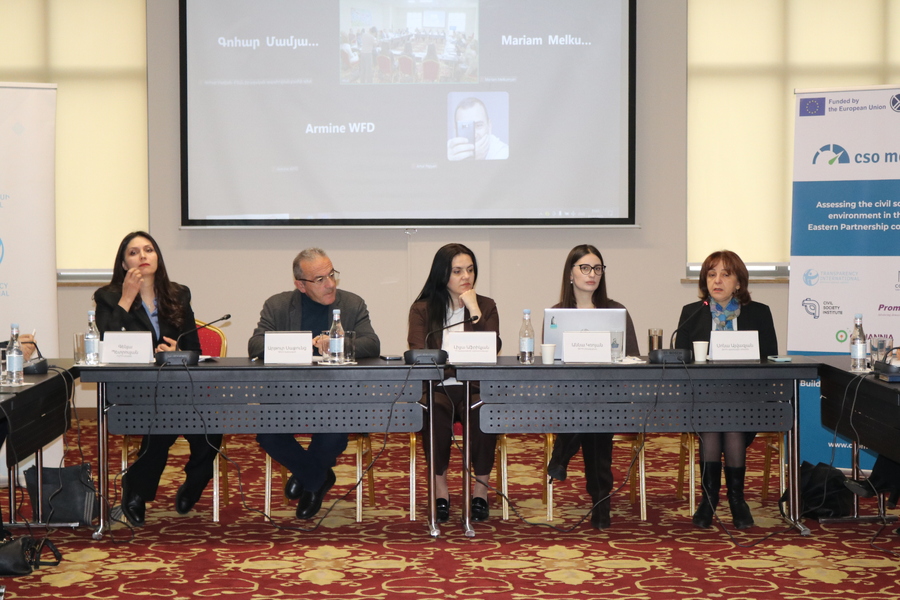"Akanates" observation mission's statement on June 20, 2021 early parliamentary election
The Akanates observation mission conducted both long-term and short-term observation of the June 20, 2021 early parliamentary election in Armenia.
The mission deployed 580 observers to a sample of 300 polling stations across the entire territory of Armenia. In addition, 22 mobile observer teams visited another 150 polling stations outside of the sample, and 33 observers followed the activities of 33 territorial electoral commissions (TECs).
The polling stations included in the sample of 300 were selected through a random representative sample and include a parallel vote tabulation (PVT) exercise.
The PVT statistical approach provides a reliable measure for evaluating election-day processes, including polling station opening, voting, polling station closing, and summarizing the results, as well as the distribution of votes among parties.
Although the observation mission did not cover all 2008 polling stations, sample-based PVT still allows to speak of the electoral process and results received, at the national level. It can verify or question the official election results which can help build confidence in the electoral outcome․
According to our observations, election day saw engaged and active participation from citizens. The process was fundamentally organized, smooth, and without serious violations. Nevertheless, a number of polling stations had a palpable level of tension, mostly due to the presence of unauthorized persons inside the polling station, who sometimes directed voters, exceeded the maximum number (2) of proxies per political party and cast the secrecy of vote into doubt. Although violations were noted on the part of representatives for multiple parties and alliances (I'm Honored Alliance, Prosperous Armenia Party, Civil Contract Party, Awakening National Christian Party, Armenian National Congress Party, Shirinyan-Babajanyan Democrats' Alliance), the majority of violations involved representatives of the Armenia Alliance.
Set up and opening
The morning preparation and polling station opening process was conducted, for the most part, in accordance with the procedures set out in the Electoral Code, without serious violations.
At 7:00 am, 96.3% of our observers submitted their initial check-in reports. There was one incidence recorded where an observer was temporarily not permitted to enter the premises to observe the morning preparation, but it was resolved before poll opening at 8:00 am.
The presence of unauthorized persons was recorded at 2% of polling stations. At 99% of polling stations, the data was correctly imported into the Voter Authentication Devices (VADs) and references on lack of voter participation were printed successfully.
At 99.6% of observed polling stations, the furnishing was arranged appropriately to maintain the secrecy of the vote. At 4 polling stations, there were issues with the room setup, which were mostly corrected.
27.5% of polling stations were not accessible for voters with disabilities.
Most polling stations opened on time. 8% were opened earlier than 8:00 am, 9% were opened between 8:01-8:10 am, and 1% were opened after 8:11 am.
The Voting Process
The voting process was generally calm, with wide engagement from voters. It was organized and conducted in accordance with legal requirements. Nevertheless, a number of polling stations had a palpable level of tension, mostly due to the presence of unauthorized persons inside the polling station, who sometimes directed voters, exceeded the maximum number (2) of proxies per political party and cast the secrecy of vote into doubt.
At 1.33% of polling stations, the rights of persons who have the right to be present inside polling stations were hindered. The PECs mostly recorded incidents highlighted by observers in the official polling station register; however, at 6.66% of polling stations, the PEC refused to record one or more incidents in the register. At 15.6% of polling stations, there were between 1-3 cases of voters who found signatures next to their names . At 0.67% of polling stations, because of a signature in front of a voter's name, they were not allowed to vote (in 1-3 cases).
There were no serious issues recorded in relation to the VADs. At 25% of polling stations, some voters were not included on the device (1-3 cases), with 4-10 cases at 1.33% of polling stations, and more than 11 cases at 0.33% of polling stations
2 cases of attempt to vote instead of another voter or multiple voting was recorded.
There have been a sizeable number of cases where the secrecy of vote was violated; moreover, they were intentional at 3.33% of polling stations. At 15% of polling stations, there were between 1-3 cases of open voting, 4-10 cases at 3.67%, and 11 or more such cases at 0.67%. The custom of family voting continued to be widespread. At 23.67% of precincts there were between 1-3 cases of family voting, 4-10 cases at 7.33% and more than 11 cases at 2.67%.
At 8% of polling stations, there were instances of directed voting. At 4.67% of polling stations, observers noted organized transportation of voters to the poll.
At 4.67% of polling stations, there was more than 1 case of violation voter assistance procedures.
2.67% of polling stations were closed ahead of the correct time of 8:00 pm. 94% were closed at on time. 3.33% closed between 8:01 and 8:10 pm.
Counting process
In general, the work of the PECs in counting the ballots was in compliance with the law. Violations of vote summarization procedures were recorded at 1.69% of polling stations and vote counting procedures at at 2.03%.
At 93.92% of polling stations, observers received an official extract of the protocol. At 1.01% of polling stations, there were unauthorized persons present. A number of polling stations temporarily experienced a widespread electricity outage. However, observers reported that it did not impede the counting process as power was restored after several minutes.
Critical Violations
Besides procedural and technical issues, observers reported a number of critical violations on the Election Day. They are summarized in the following table into categories. A total of 93 substantial violations were reported during the voting and counting process; these cases are still under review.
| Type of Violation | Quantity |
|---|---|
| Impeding rights of an observer | 8 |
| Presence of unauthorized persons | 15 |
| Issues with the safe | 6 |
| Violence, threats or instances of intimidation | 3 |
| Attempt for voting instead of another person/multiples voting | 3 |
| Violation of voter assistance procedures | 2 |
| Open, controlled or directed voting | 30 |
| Deliberate destruction of ballot papers | 1 |
| Serious violations of the summarization of results process | 7 |
| Refusal by the PEC to record an observer's assessment in the official register | 22 |
Results Projection and Turnout Figures based on the Parallel Vote Tabulation (PVT)
Below are the ranges projected PVT for each party. These ranges are determined by the PVT estimates and the margins of error, based on a 95% confidence level.
| Name of Political Party or Alliance | Percentage of Votes | Error | Expected Range |
|---|---|---|---|
| Fair Armenia Party | 0.33% | 0.08% | 0.3% to 0.4% |
| Armenian National Congress Party | 1.49% | 0.15% | 1.3% to 1.6% |
| Civil Contract Party | 54.04% | 1.87% | 52.2% to 55.9% |
| Awakening National Christian Party | 0.33% | 0.05% | 0.3% to 0.4% |
| Freedom Party | 0.13% | 0% | 0.1% to 0.2% |
| I’m Honored Alliance | 5.34% | 0.66% | 4.7% to 6% |
| United Homeland Party | 0.06% | 0% | 0% to 0.1% |
| Pan-Armenian National Statehood Party | 0.07% | 0% | 0.1% to 0.1% |
| Bright Armenia Party | 1.14% | 0.13% | 1% to 1.3% |
| Our Home is Armenia Party | 1.04% | 0.16% | 0.9% to 1.2% |
| Republic Party | 3.00% | 0.31% | 2.7% to 3.3% |
| Armenians' Homeland Party | 1.04% | 0.11% | 0.9% to 1.1% |
| Free Homeland Alliance | 0.32% | 0.05% | 0.3% to 0.4% |
| Prosperous Armenia Party | 3.89% | 0.58% | 3.3% to 4.5% |
| Democratic Party of Armenia | 0.36% | 0.05% | 0.3% to 0.4% |
| 5165 National Conservative Movement Party | 1.25% | 0.12% | 1.1% to 1.4% |
| Citizen’s Decision Social-Democratic Party | 0.33% | 0.05% | 0.3% to 0.4% |
| Shirinyan-Babajanyan Democrats’ Alliance | 1.39% | 0.12% | 1.3% to 1.5% |
| National Agenda Party | 0.07% | 0% | 0% to 0.1% |
| Ascent Party | 0.11% | 0% | 0.1% to 0.1% |
| Liberal Party | 1.20% | 0.15% | 1% to 1.3% |
| European Party of Armenia | 0.22% | 0% | 0.2% to 0.3% |
| Armenia Alliance | 21.10% | 1.29% | 19.8% to 22.4% |
| National-Democratic Axis Pan-Armenian Party | 1.41% | 0.14% | 1.3% to 1.5% |
| Sovereign Armenia Party | 0.32% | 0.05% | 0.3% to 0.4% |
The PVT projection for final turnout is 49.3% with a margin of error of +/- 0.9%. Invalid ballots were reported at 0.38% with a margin of error +/- 0.05%.
Territorial Electoral Commissions (TECs)
The Akanates observation mission also observed the work of 33 TECs. The tabulation of PEC results went smoothly. Observers did communicate some violations, which are currently under review.
The data received from observers is still undergoing a review process to ensure the accuracy of the PVT exercise and follow up with TECs. As a result of these reviews, individual cases of substantive violations may lead to a formal complaint with electoral and law enforcement bodies.
"Akanates" observation mission was founded in 2018 by Transparency International Anticorruption Center, Journalists' Club "Asparez", "Restart" Scientific and Educational Foundation and Law Development and Protection Foundation. The goal of "Akanates" is to promote free and fair elections, integrity of electoral processes and public oversight over these processes.
This mission was made possible by the financial support from the European Union, National Endowment for Democracy, European Endowment for Democracy, Organisation internationale de la Francophonie, the Black Sea Trust, a project of the German Marshall Fund of the United States, Open Society Foundations – Armenia. Parallel vote tabulation was conducted with technical support from the National Democratic Institute.
The contents are responsibility of "Akanates" observation mission and its member organizations and do not necessarily reflect the official views of donor organizations.







